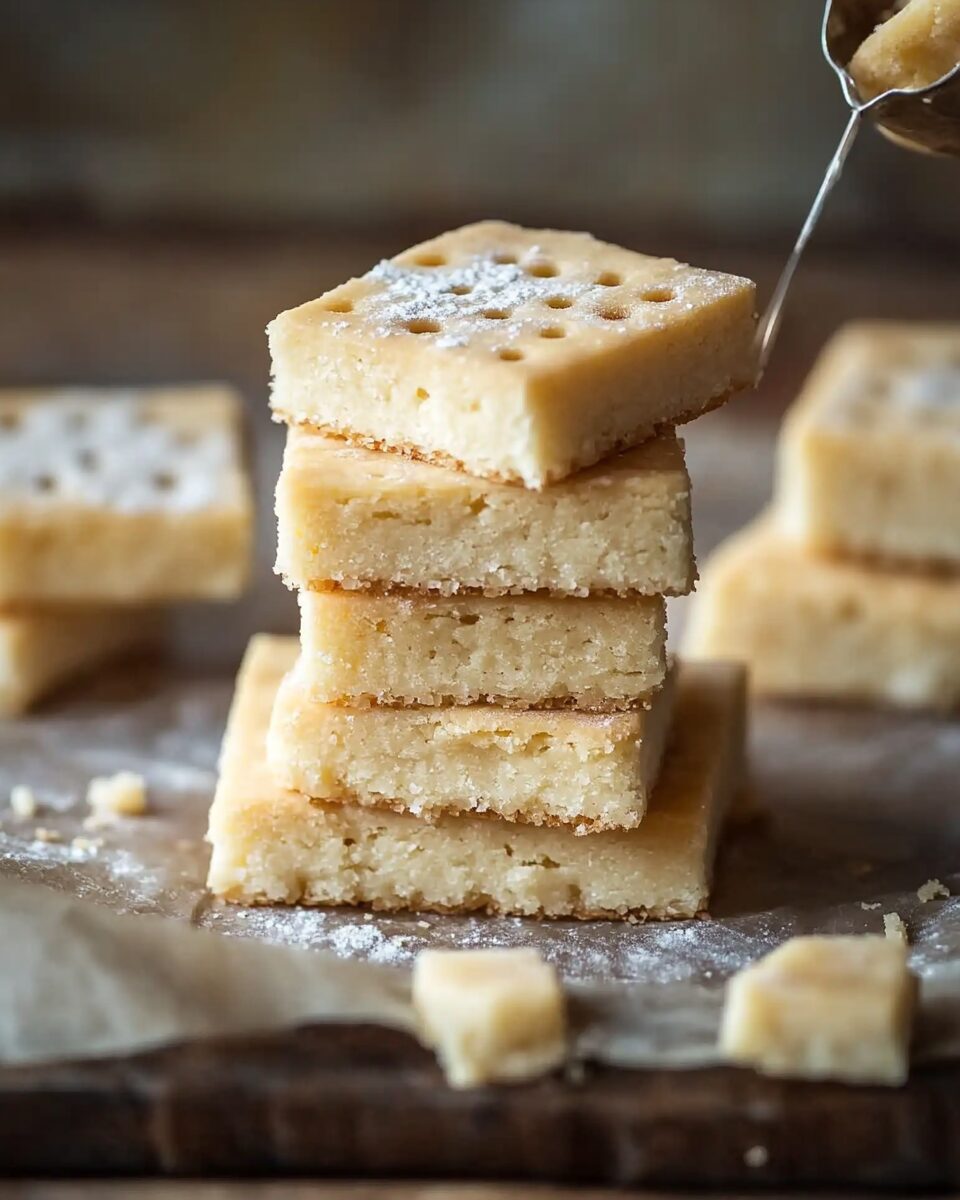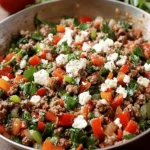Cornish Clotted Cream Shortbread is a delightful twist on traditional shortbread, incorporating rich Cornish clotted cream to enhance its silkiness and tenderness. The addition of cornstarch and oat flour ensures a melt-in-your-mouth texture, making each bite a luxurious experience.
FULL RECIPE:
Ingredients
- 1 cup (225g) unsalted butter, softened
- 1/2 cup (120g) Cornish clotted cream
- 1 cup (200g) granulated sugar
- 2 cups (250g) all-purpose flour
- 1/2 cup (60g) oat flour
- 1/4 cup (30g) cornstarch
- 1/2 teaspoon salt
- 1 teaspoon vanilla extract
Directions
- Preheat the Oven: Set your oven to 325°F (163°C). Line a baking sheet with parchment paper.
- Cream Butter and Sugar: In a large bowl, beat the softened butter, clotted cream, and granulated sugar together until light and fluffy.
- Add Dry Ingredients: In a separate bowl, whisk together the all-purpose flour, oat flour, cornstarch, and salt. Gradually add this mixture to the creamed butter, mixing until just combined.
- Incorporate Vanilla: Stir in the vanilla extract until evenly distributed throughout the dough.
- Shape the Dough: Transfer the dough onto a lightly floured surface. Roll it out to a thickness of about 1/2 inch (1.25 cm).
- Cut into Shapes: Use a cookie cutter to cut the dough into desired shapes. Place the pieces onto the prepared baking sheet, spacing them about 1 inch apart.
- Bake: Bake in the preheated oven for 18-20 minutes, or until the edges are lightly golden.
- Cool: Remove from the oven and allow the shortbread to cool on the baking sheet for 5 minutes before transferring to a wire rack to cool completely.
Nutrients
- Serving Size: 1 piece (assuming the recipe yields 24 pieces)
- Calories: 150
- Total Fat: 9g
- Saturated Fat: 5.5g
- Cholesterol: 25mg
- Sodium: 50mg
- Total Carbohydrates: 16g
- Dietary Fiber: 0.5g
- Sugars: 6g
- Protein: 1.5g
History and Origin of Cornish Clotted Cream Shortbread
Cornish Clotted Cream Shortbread has its roots in the rich culinary history of Cornwall, England. The use of clotted cream dates back centuries, originating as a method to preserve milk. Over time, it became a staple in traditional Cornish cuisine, especially in desserts. Shortbread, on the other hand, is a Scottish invention known for its buttery and crumbly texture. The fusion of these two elements, Cornish clotted cream and classic shortbread—creates a luxurious treat that perfectly balances tradition with indulgence. Shortbread itself has been a favorite since medieval times, with early versions appearing in Scotland around the 12th century. It was initially made from leftover bread dough, but over time, bakers replaced yeast with butter, leading to the rich, melt-in-your-mouth delicacy we know today. Cornish clotted cream enhances this classic recipe, offering a uniquely velvety texture and depth of flavor that sets it apart from ordinary shortbread.
Why Cornish Clotted Cream Makes a Difference
The defining ingredient in this shortbread is Cornish clotted cream, a dairy product renowned for its thick consistency and rich, slightly caramelized flavor. Unlike regular cream, clotted cream is made by slowly heating full-fat cow’s milk and allowing it to cool, forming a thick layer of cream on the surface. This method not only intensifies its natural sweetness but also results in a uniquely silky texture. When incorporated into shortbread, clotted cream provides a depth of richness that cannot be achieved with butter alone. It enhances the buttery nature of the shortbread while introducing a subtle nutty undertone, making the texture even more delicate and crumbly.
Texture and Flavor Profile
Cornish Clotted Cream Shortbread stands out because of its melt-in-the-mouth consistency. Traditional shortbread is already well-loved for its crisp yet tender texture, but adding clotted cream takes it a step further. The result is a balance between a crisp edge and a soft, almost creamy bite. Flavor-wise, this shortbread has a distinct buttery richness with a slight caramelized undertone from the clotted cream. The mild sweetness allows the cream’s natural dairy flavors to shine through without being overpowering. Some bakers like to enhance the shortbread with a pinch of sea salt to bring out the complexity of flavors.
Best Ways to Serve Cornish Clotted Cream Shortbread
This shortbread is incredibly versatile and can be enjoyed in various ways:
- With Afternoon Tea – Traditionally, shortbread pairs perfectly with a cup of English breakfast tea, Earl Grey, or even herbal infusions like chamomile and lavender.
- As a Dessert Base – The rich, buttery nature of the shortbread makes it an excellent base for layered desserts such as cheesecakes or crumbles.
- With Fresh Fruit and Jams – A simple yet elegant way to serve Cornish Clotted Cream Shortbread is with fresh berries and a dollop of jam or honey.
- Dipped in Chocolate – Some enjoy dipping shortbread in melted dark or milk chocolate for a decadent twist.
- With Ice Cream – Crumbled over vanilla or caramel ice cream, it adds an extra layer of texture and richness.
Storage and Shelf Life
One of the great advantages of shortbread is its excellent shelf life. Properly stored, Cornish Clotted Cream Shortbread can remain fresh for up to a week at room temperature. Here are some storage tips:
- Airtight Containers – Store in an airtight container to prevent moisture from affecting the crisp texture.
- Cool, Dry Place – Keep it in a cool, dry spot away from direct sunlight.
- Refrigeration – If you live in a warm climate, refrigerate the shortbread to prevent the clotted cream content from altering the texture.
- Freezing – Shortbread can also be frozen for up to three months. Simply place them in a freezer-safe container and thaw at room temperature before serving.
Variations of Cornish Clotted Cream Shortbread
While the traditional recipe is already rich and flavorful, there are several variations to explore:
- Lemon or Orange Zest – Adding citrus zest brightens up the buttery richness.
- Spiced Shortbread – A touch of cinnamon, nutmeg, or cardamom can add warmth to the flavor.
- Chocolate Chip Shortbread – Incorporating chocolate chips into the dough gives a sweet contrast to the creamy texture.
- Nutty Shortbread – Finely chopped almonds, hazelnuts, or pistachios add a delightful crunch.
- Herbal Infused – A hint of lavender or rosemary can bring a sophisticated twist to the traditional shortbread.
Cultural Significance and Popularity
Cornish Clotted Cream Shortbread is not just a treat but a representation of Cornwall’s rich dairy heritage. Clotted cream itself is a protected food product under the European Union’s Protected Designation of Origin (PDO) status, meaning only cream produced in Cornwall using traditional methods can be called “Cornish Clotted Cream.” This strict standard ensures the authenticity and quality of the ingredient used in the shortbread. Due to its luxurious texture and taste, this shortbread is highly popular not only in the UK but also internationally. It is often found in high-end tea shops, gourmet bakeries, and gift hampers, especially during the holiday season.
Conclusion
Cornish Clotted Cream Shortbread is a decadent twist on traditional shortbread, offering a rich, melt-in-your-mouth experience that highlights the best of Cornish dairy craftsmanship. The addition of clotted cream enhances both texture and flavor, making it an exceptional treat for any occasion. Whether enjoyed with tea, paired with fruit, or given as a gift, this shortbread embodies the perfect balance of tradition and indulgence. Its versatility, long shelf life, and simple yet elegant flavor profile make it a must-try for anyone who appreciates fine baking.






